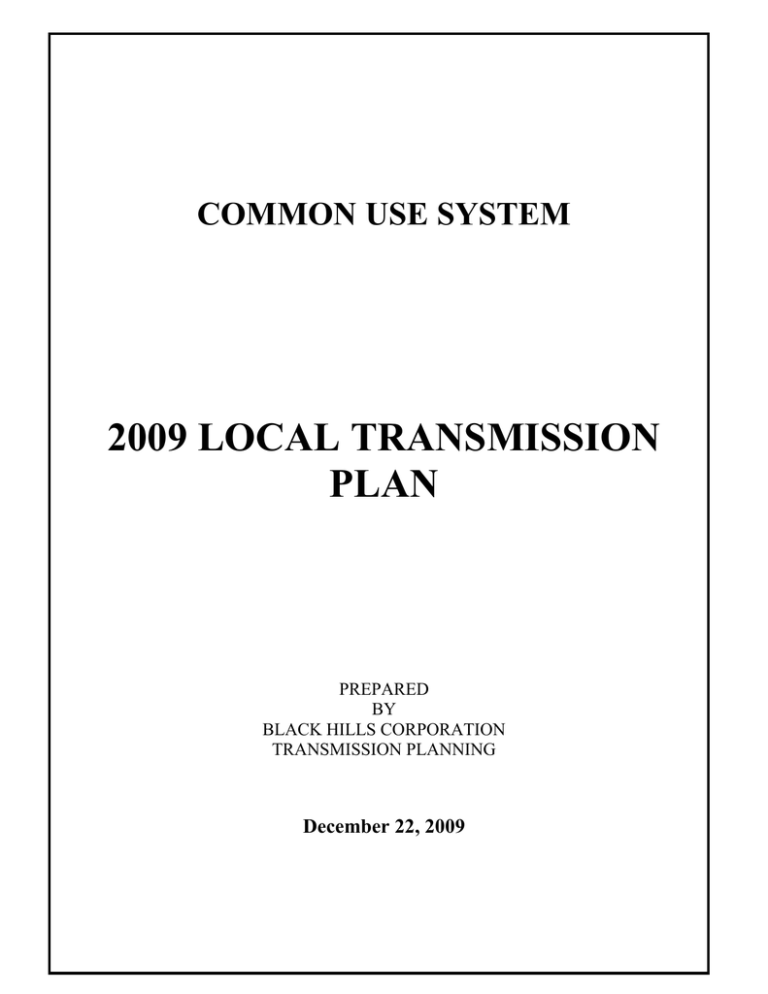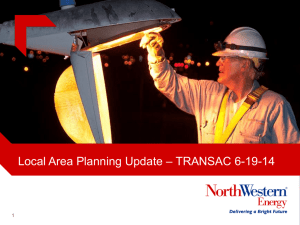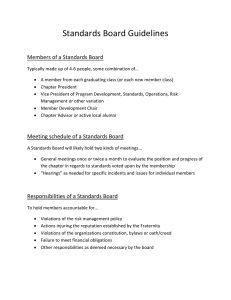DRAFT TCPC Report (December 22, 2009) Updated:2010-01-07 17:34 CS
advertisement

COMMON USE SYSTEM 2009 LOCAL TRANSMISSION PLAN PREPARED BY BLACK HILLS CORPORATION TRANSMISSION PLANNING December 22, 2009 1 ____________________________________________________________________________________________________________ Common Use System: Transmission Coordination and Planning Committee 2009 Local Transmission Plan December 22, 2009 Table of Contents 1. 2. 3. 4. 5. Introduction ............................................................................................................................... 4 1.1. Common Use Transmission System Background .......................................................... 4 1.2. Stakeholder Participation ................................................................................................ 5 Study Methodology ................................................................................................................... 5 2.1. Study Criteria .................................................................................................................... 5 2.2. Study Area ......................................................................................................................... 6 2.3. Study Case Development .................................................................................................. 6 2.4. Evaluated Scenarios .......................................................................................................... 7 2.5. Transmission Planning Assumptions .............................................................................. 8 Evaluation of the Common Use Transmission System .......................................................... 8 3.1. Steady-State Analysis ....................................................................................................... 9 3.2. Transient Analysis .......................................................................................................... 12 Transmission System Expansion ........................................................................................... 14 4.1. Additional Belle Creek 69 kV reactive voltage support .............................................. 14 4.2. Additional Osage 69 kV reactive voltage support........................................................ 14 4.3. Additional Moorcroft 69 kV reactive voltage support ................................................ 14 4.4. 230 kV breaker replacement at Wyodak ...................................................................... 14 4.5. Additional 230:69 kV transformation capacity............................................................ 14 Conclusions .............................................................................................................................. 15 2 ____________________________________________________________________________________________________________ Common Use System: Transmission Coordination and Planning Committee 2009 Local Transmission Plan December 22, 2009 List of Tables Table 1: Steady State Voltage Criteria ........................................................................................... 5 Table 2: Common Use Transmission System Interconnection Points ......................................... 6 Table 3: Near-Term Prior Outage List ........................................................................................... 9 Table 4: Transient Analysis Fault Summary ............................................................................... 13 List of Figures Figure 1: Common Use Transmission System ............................................................................... 4 3 ____________________________________________________________________________________________________________ Common Use System: Transmission Coordination and Planning Committee 2009 Local Transmission Plan December 22, 2009 1. Introduction In December of 2007, the Common Use System (CUS) participants filed with FERC Attachment K to the Joint Open Access Transmission Tariff (JOATT) to meet the requirements outlined in FERC Order 890. Through their Attachment K filing, the CUS participants created the Transmission Coordination and Planning Committee (TCPC) as the forum to conduct longrange planning studies while promoting stakeholder input and involvement. This report, intended to serve as the 2009 Local Transmission Plan (LTP), will outline the 2009 study cycle and present the findings of the planning study. 1.1. Common Use Transmission System Background Black Hills Power, Inc., Basin Electric Power Cooperative and Powder River Energy Corporation (referred to hereinafter as the Transmission Provider) each own certain transmission facilities with transmission service pursuant to a FERC-approved Joint Open Access Transmission Tariff (“JOATT”). The Transmission Provider commonly refers to these facilities as the Common Use System (“CUS”). A diagram of the CUS is shown in Figure 1. MONTANA 2009 TONGUE RIVER (2009) WYOMING LEITER TAP (2009) 2009 SHERIDAN DRY FORK (2011) DRY FORK 2009 CARR DRAW BUFFALO LOOKOUT 2009 ST. ONGE (2013) WYODAK YELLOW CREEK HUGHES WYGEN2 WYGEN3 (2010) LANGE 2015 DONKEY CREEK BARBER CREEK 2009 RENO OSAGE SOUTH RAPID RAPID CITY DC TIE 100 MVAR CAPS (2009) 2013 PUMPKIN BUTTES TECKLA MINNEKHATA (2011) WESTHILL 2010 YELLOWCAKE SOUTH DAKOTA SPENCE WINDSTAR NEBRASKA CASPER 230 KV (EXISTING) DAVE JOHNSTON 230 KV (FUTURE) SUBSTATION MIRACLE MILE STEGALL GENERATOR Figure 1: Common Use Transmission System 4 ____________________________________________________________________________________________________________ Common Use System: Transmission Coordination and Planning Committee 2009 Local Transmission Plan December 22, 2009 1.2. Stakeholder Participation All interested parties were encouraged to participate in the 2009 TCPC study process. An open stakeholder kick-off meeting was held on March 4, 2009 in Rapid City, SD to inform stakeholders of the proposed study plan and to provide an opportunity for suggestions and feedback on the study process. Requests for data pertaining to the modeling and evaluation of the transmission system were made by the Transmission Provider. Meeting notices were distributed via email and posted along with presentation materials on the Black Hills OASIS page at http://www.oatioasis.com/BHBE/index.html. 2. Study Methodology The current transmission system was evaluated with planned system additions under both peak summer and off-peak winter load levels to identify any significant adverse impact to the reliability and operating characteristics of the Western Electricity Coordinating Council (WECC) bulk transmission system and, more specifically the CUS and surrounding transmission system. Steady state voltage and thermal analyses examined system performance with planned projects in-service. Additional upgrades were identified and modeled as necessary to mitigate any reliability criteria violations. System performance was then reevaluated to test the adequacy of the identified upgrades. A list of forced outages used in the 2009 LTP study process is available upon request. 2.1. Study Criteria The criteria described in 2.1.1 and 2.1.2 are consistent with the NERC TPL Reliability Standards, WECC TPL – (001 thru 004) – WECC – 1 – CR ─ System Performance Criteria and Colorado Coordinated Planning Group’s Voltage Coordination Guide. 2.1.1. Steady State Voltage Criteria Table 1 identifies the steady state voltage criteria used in or around the primary study area for the assessment. Pre-existing voltage violations outside the localized study area were ignored during the evaluation. Table 1: Steady State Voltage Criteria Voltage Class 69 kV and above Acceptable Voltage Range System Normal Outage Conditions (NERC/WECC (NERC/WECC Category A) Category B and C) 0.95 to 1.05 p.u. 0.90 to 1.10 p.u. 2.1.2. Steady State Thermal Criteria All line and transformer loading must be less than 100% of their established continuous rating for system normal conditions (NERC/WECC Category A). All line 5 ____________________________________________________________________________________________________________ Common Use System: Transmission Coordination and Planning Committee 2009 Local Transmission Plan December 22, 2009 and transformer loadings must be less than 100% of their established continuous or emergency rating under outage conditions (NERC/WECC Category B and C). 2.1.3. Transient Voltage and Frequency Criteria NERC Standards require that the system remain stable for Category A, B, and C disturbances. The following criteria were used to determine acceptable transient system performance: All machines in the system shall remain in synchronism as demonstrated by their relative rotor angles. System stability is evaluated based on the damping of the relative rotor angles and the damping of the voltage magnitude swings. For central, northern and eastern Wyoming and western South Dakota, the following dynamic stability guidelines have been established: Following a single contingency disturbance with normal fault clearing, the bus voltage transient swing on all buses should not be lower than 0.70 p.u., and the system should exhibit positive damping. Additionally, the WECC off normal frequency criteria guidelines for N-1 (59.6 Hz) and N-1-1 or N-2 (59.0 Hz) will be followed. 2.2. Study Area The 2009 LTP study area will include all CUS transmission equipment as well as neighboring transmission system elements bound by TOT4B to the northwest, TOT4A to the southwest, Laramie River Station and Stegall to the southeast, and Rapid City to the east. Points of interconnection between the CUS and neighboring utilities are shown in Table 2. Table 2: Common Use Transmission System Interconnection Points Interconnection Name Sheridan Carr Draw Wyodak Antelope Stegall Rapid City DC Tie Interconnecting Utility City of Sheridan PacifiCorp PacifiCorp PacifiCorp WAPA-RMR WAPA-UPGR 2.3. Study Case Development The baseline cases for the 2009 LTP Study were chosen based upon WECC Base Case availability, planned transmission system and resource upgrades, and previously completed planning studies. 2.3.1. 2014 Heavy Summer Study Case 6 ____________________________________________________________________________________________________________ Common Use System: Transmission Coordination and Planning Committee 2009 Local Transmission Plan December 22, 2009 A 2008 CCPG study case updated for planning study use by Tri-State G&T was used as the starting point for the 2014 summer peak analysis. Updates to the case loads, resources, and topology were solicited from neighboring systems and applied to the model. Significant resource additions to the Common Use transmission system from the 2009 existing configuration included the addition of the Wygen 3 plant and a clone of Wygen 3 online at the Donkey Creek sub, and the Dryfork plant online. Transmission system additions include the Pumpkin Buttes-Windstar 230 kV line inservice, along with the Teckla-Osage-Lange 230 kV line, a second Donkey CreekWyodak 230 kV circuit, the Minnekhata 230:69 kV substation, and the St. Onge 230:69 kV substation. 2.3.2. 2015 Light Winter Study Case The WECC-approved 2013LW study case updated for planning study use by Tri-State G&T was used as the starting point for the 2014 light winter analysis. Updates to the case loads, resources, and topology were solicited from neighboring systems and applied to the model. Significant system additions to the Common Use transmission system from the 2009 existing configuration were similar to those specified in 2.3.2, with the exception of local wind generation dispatched at 30% capacity including wind resources at Pumpkin Buttes. 2.3.3. 2020 Heavy Summer Study Case The 2019HW CCPG Compliance Study case was used as the starting point for the 2020 summer peak analysis. Updates to the case loads, resources, and topology were solicited from neighboring systems and applied to the model. There were numerous changes affecting the Common Use transmission system modeled for the 2020 analysis. These included the Energy Gateway project from Windstar to the west and south, additional base load generation capacity at Donkey Creek, and additional transmission across the TOT3 path. 2.3.4. 2020 Light Winter Study Case The 2019HW CCPG Compliance Study case was also used as the starting point for the 2020 light winter analysis. Updates to the case loads, resources, and topology were solicited from numerous entities in the CCPG footprint and applied to the model. Significant system additions to the Common Use transmission system from the 2009 existing configuration were similar to those specified in 2.3.3, with the exception of local wind generation dispatched at 30% capacity including wind resources at Pumpkin Buttes. 2.4. Evaluated Scenarios 2.4.1. Case Naming Convention Study case designations were formatted as shown in Figure 2: 7 ____________________________________________________________________________________________________________ Common Use System: Transmission Coordination and Planning Committee 2009 Local Transmission Plan December 22, 2009 Prior Outage_RC Generation_Osage-Lange 230 kV line Prior Outage: See Tables 3 and 4 RC Generation: NC 20 MW online in Rapid City RCGEN5 100 MW online in Rapid City Osage-Lange 230 kV line: NC** OL230 Osage-Lange 230 kV line not in service Osage-Lange 230 kV line in service **Note: The Osage-Lange 230 kV line was in service for all 2020HS and LW scenarios Figure 2: Study Case Naming Convention 2.5. Transmission Planning Assumptions The 2009 LTP study was performed for both the 2014 and 2020 time frames with the following assumptions: All existing and planned facilities and the effects of control devices and protection systems were accurately represented in the system model. Projected firm transfers were represented per load and resource updates from each stakeholder. Existing and planned reactive power resources were modeled to ensure adequate system performance. Known planned outages related to maintenance or otherwise were simulated for the system facilities deemed to be the most critical by the transmission planner. No known planned outages were identified for the time periods contemplated in this study. Each scenario described in Section 2.3 was evaluated to meet the requirements of all applicable NERC and WECC reliability standards and criteria. 3. Evaluation of the Common Use Transmission System A number of thermal overloads or voltage violations on the CUS were identified in the initial analysis. These issues were resolved by applying or modifying existing operating procedures including the dispatch of additional gas-fired generation, switching of capacitor banks, and reconfiguring of the normal open points on the 69 kV system. Most of the voltage and thermal criteria violations that were mitigated using these methods were excluded from the report. The Osage plant is currently scheduled for retirement by December 31, 2012. The retirement of this resource makes the Osage 69 kV system prone to depressed voltages when the Osage 230:69 kV transformer is out of service. A second 10 MVAR capacitor was modeled at the 8 ____________________________________________________________________________________________________________ Common Use System: Transmission Coordination and Planning Committee 2009 Local Transmission Plan December 22, 2009 Osage 69 kV bus for all study scenarios to mitigate the voltage violations associated with the plant retirement. A second 2.1 MVAR capacitor at the Belle Creek 69 kV bus is currently out of service. The capacitor was placed into service for all study scenarios to mitigate anticipated low voltages along the Sundance Hill-Belle Creek 69 kV line. 3.1. Steady-State Analysis 3.1.1. Prior Outages A list of the prior outages that were evaluated for the near-term and far-term steady state assessments are included in Tables 3 and 4, respectively: Table 3: Near-Term Prior Outage List Steady State 2014 HS and LW Prior Outage List 1 SYSTEM INTACT 21 WYODAK-DONKEY CRK 41 WESTHILL XFMR 2 GOOSE CRK-SHERIDAN 22 WYODAK-OSAGE 42 OSAGE XFMR 3 BUFFALO-SHERIDAN 23 WYODAK-HUGHES 43 HUGHES XFMR 4 BUFFALO-KAYCEE 24 HUGHES-LOOKOUT 44 LANGE XFMR 2 5 CASPER-CLAIMJPR 25 YELLOW CRK-OSAGE 45 ST. ONGE XFMR 6 CASPER-DJ 26 LOOKOUT-YELLOW CRK 46 YELLOWCREEK XFMR 7 SHERIDAN-T. RIVER 27 OSAGE-MINNEKHATA 47 SOUTH RAPID XFMR 8 T. RIVER-ARVADA 28 LANGE-SO_WIND 48 TECKLA-OSAGE 9 ARVADA-DRYFORK 29 LANGE-SOUTH RAPID 49 OSAGE-LANGE 10 DRYFORK-CARR DRAW 30 SOUTH RAPID-WESTHILL 50 ST. ONGE XFMR 11 DRYFORK-HUGHES 31 RCDCW-SOUTH RAPID 51 MINNEKHATA-WESTHILL 12 BUFFALO-CARR DRAW 32 WESTHILL-STEGALL 52 MINNEKHATA XFMR 13 WYODAK-CARR DRAW 33 WYODAK UNIT 53 P. BUTTES-WINDSTAR 14 CARR DRW-BARBER CRK 34 WYGEN1 UNIT 54 WYGEN3 UNIT 15 BARBER CRK- P. BUTTES 35 WYGEN2 UNIT 55 SO_WIND-ST. ONGE 16 P. BUTTES -TECKLA 36 LRS UNIT 56 17 TECKLA-ANTELOPE 37 DJ UNIT #4 57 18 RENO-TECKLA 38 CASPER XFMR 58 19 DONKEY CRK-RENO 39 DJ XFMR 59 20 DONKEY CRK- P. BUTTES 40 WYODAK XFMR 2 60 9 ____________________________________________________________________________________________________________ Common Use System: Transmission Coordination and Planning Committee 2009 Local Transmission Plan December 22, 2009 Table 4: Far-Term Prior Outage List Steady State 2020 HS and LW Prior Outage List 1 SYSTEM INTACT 21 WYODAK-DONKEY CRK 41 WESTHILL XFMR 2 GOOSE CRK-SHERIDAN 22 WYODAK-OSAGE 42 OSAGE XFMR 3 BUFFALO-SHERIDAN 23 WYODAK-HUGHES 43 HUGHES XFMR 4 BUFFALO-KAYCEE 24 HUGHES-LOOKOUT 44 LANGE XFMR 2 5 CASPER-CLAIMJPR 25 YELLOW CRK-OSAGE 45 ST. ONGE XFMR 6 CASPER-DJ 26 LOOKOUT-YELLOW CRK 46 YELLOWCREEK XFMR 7 SHERIDAN-T. RIVER 27 OSAGE-MINNEKHATA 47 SOUTH RAPID XFMR 8 T. RIVER-ARVADA 28 LANGE-SO_WIND 48 TECKLA-OSAGE 9 ARVADA-DRYFORK 29 LANGE-SOUTH RAPID 49 OSAGE-LANGE 10 DRYFORK-CARR DRAW 30 SOUTH RAPID-WESTHILL 50 ST. ONGE XFMR 11 DRYFORK-HUGHES 31 RCDCW-SOUTH RAPID 51 MINNEKHATA-WESTHILL 12 BUFFALO-CARR DRAW 32 WESTHILL-STEGALL 52 MINNEKHATA XFMR 13 WYODAK-CARR DRAW 33 WYODAK UNIT 53 P. BUTTES-WINDSTAR 14 CARR DRW-BARBER CRK 34 WYGEN1 UNIT 54 WYGEN3 UNIT 15 BARBER CRK- P. BUTTES 35 WYGEN2 UNIT 55 SO_WIND-ST. ONGE 16 P. BUTTES -TECKLA 36 LRS UNIT 56 WINDSTAR-AEOLUS 500 17 TECKLA-TRICOUNTY 37 DJ UNIT #4 57 18 RENO-TECKLA 38 CASPER XFMR 58 19 DONKEY CRK-RENO 39 DJ XFMR 59 20 DONKEY CRK- P. BUTTES 40 WYODAK XFMR 2 60 3.1.2. 2014 Heavy Summer Results The 2014 summer peak case exhibited thermal overloads on two Black Hills transmission system elements: The Lookout 230:69 kV transformer exceeded its emergency thermal limit following the N-1-1 combination of the South Rapid City-Westhill and Lookout-St. Onge 230 kV lines or the Lookout-St. Onge 230 kV line and the Yellowcreek 230:69 kV transformer. The Yellowcreek 230:69 kV transformer exceeded its emergency thermal limit due to the following N-1-1 outage combinations: South Rapid City-Westhill + Lookout-St. Onge 230 kV lines Lookout-Hughes + Lookout-Yellowcreek 230 kV lines St. Onge + Lookout 230:69 kV transformers St. Onge-Lookout 230 kV line + Lookout 230:69 kV transformer All of the above violations occurred in the scenario without the Osage-Lange 230 kV line in service. The addition of this line mitigated all thermal overload violations. 10 ____________________________________________________________________________________________________________ Common Use System: Transmission Coordination and Planning Committee 2009 Local Transmission Plan December 22, 2009 Low voltages occurred at Moorcroft and Hughes following the prior outage of the Hughes 230:69 kV transformer plus the loss of the Wyodak-Hughes 69 kV line. The addition of a 10 MVAR capacitor at Moorcroft and a second 10 MVAR capacitor at the Osage 69 kV bus resolved the violations. 3.1.3. 2014-15 Light Winter Results The 2014-15 light winter analysis identified two prior/forced outage combinations that created low voltage violations: The prior/forced outage combination of the Osage and Hughes 230:69 kV transformers created low voltages on the Hughes-Moorcroft-Osage-Newcastle 69 kV system. The addition of 10 MVAR capacitors at Osage and Moorcroft resolved the violations. The prior outage of the Hughes 230:69 kV transformer followed by the loss of the Wyodak-Hughes 69 kV line created low voltage violations at Moorcroft and Hughes. The addition of a 12 MVAR capacitor at Moorcroft and a second 10 MVAR capacitor at Osage resolved the violations. The violations listed above were nearly identical for scenarios with and without the Osage-Lange 230 kV line in service. 3.1.4. 2020 Heavy Summer Results The 2020 summer peak case exhibited thermal overloads on three Black Hills transmission system elements: The Yellowcreek 230:69 kV transformer exceeded its emergency thermal limit due to the N-1-1 outage combination of the St. Onge and Lookout 230:69 kV transformers. This overload was mitigated by adding a second transformer at Lookout. Several voltage violations were identified during the 2020 heavy summer analysis: The prior outage of the Osage 230:69 kV transformer caused low voltages on the Osage and surrounding 69 kV system. These violations were mitigated by adding a second 10 MVAR cap at the Osage 69 kV bus. The prior/forced outage combination of the Osage and Hughes 230:69 kV transformers created low voltages on the Hughes-Moorcroft-Osage-Newcastle 69 kV system. The addition of a second 10 MVAR capacitor at Osage and at least 15 MVAR of capacitance at Moorcroft resolved the violations. The prior outage of the Hughes 230:69 kV transformer followed by the loss of the Wyodak-Hughes 69 kV line created low voltage violations at Moorcroft 11 ____________________________________________________________________________________________________________ Common Use System: Transmission Coordination and Planning Committee 2009 Local Transmission Plan December 22, 2009 and Hughes. The addition of a 12 MVAR capacitor at Moorcroft and a second 10 MVAR capacitor at Osage resolved the violations. 3.1.5. 2019-20 Light Winter Results The 2019-20 light winter analysis identified three outage combinations that created low voltage violations: The prior outage of the Osage 230:69 kV transformer caused low voltages on the Osage and surrounding 69 kV system. These violations were mitigated by adding a second 10 MVAR cap at the Osage 69 kV bus. The prior/forced outage combination of the Osage and Hughes 230:69 kV transformers created low voltages on the Hughes-Moorcroft-Osage-Newcastle 69 kV system. The addition of 10 MVAR capacitors at Osage and Moorcroft resolved the violations. The prior outage of the Hughes 230:69 kV transformer followed by the loss of the Wyodak-Hughes 69 kV line created low voltage violations at Moorcroft and Hughes. The addition of a 10 MVAR capacitor at Moorcroft and a second 10 MVAR capacitor at Osage resolved the violations. The simulation of Category D outages in each load scenario did not result in system instability or cascading outages. 3.2. Transient Analysis Transient analysis was performed to evaluate the dynamic characteristics of the CUS following various disturbances. A significant amount of coal bed methane (CBM) motor load exists to the south and west of Gillette, WY. The CBM load was modeled as 80 percent motor load, while the remaining system loads were modeled using the WECC generic motor penetration of 20 percent. The 3-phase faults in Table 4 were simulated for all load level scenarios in the transient analysis. The faults were simulated for cases with and without the Osage-Lange 230 kV line in service in the 2014 HS and LW scenarios. 12 ____________________________________________________________________________________________________________ Common Use System: Transmission Coordination and Planning Committee 2009 Local Transmission Plan December 22, 2009 Table 4: Transient Analysis Fault Summary Prior Outage Fault Bus (230 kV) Cleared Element System Intact Wyodak Wyodak-Carr Draw 230 line Fault Duration (cycles) 4.25 System Intact Wyodak Wyodak-Donkey Crk 230 line 4.25 System Intact Wyodak Wyodak-Hughes 230 line 4.25 System Intact Wyodak Wyodak-Osage 230 line 4.25 System Intact Dryfork Dryfork-Hughes 230 line 4.25 System Intact Dryfork Dryfork-Carr Draw 230 line 4.25 System Intact Dryfork Dryfork-T. River 230 line 4.25 System Intact Dryfork Dryfork Plant 3.50 System Intact S. Rapid S. Rapid-Westhill 230 line 4.25 System Intact Carr Draw Carr Draw-Buffalo 230 line 4.25 System Intact Windstar Windstar-P. Buttes & Windstar-Teckla 230 line 5.0 Wyodak-Osage 230 line Wyodak Wyodak-Hughes 230 line 4.25 Wyodak-Carr Draw 230 line Wyodak Wyodak-Hughes 230 line 4.25 Wyodak-Hughes 230 line Wyodak Wyodak-Osage 230 line 4.25 Lookout-Hughes 230 line Wyodak Wyodak-Osage 230 line 4.25 Wyd-Donkey Crk 230 line Wyodak Wyodak-Carr Draw 230 line 4.25 Wyd-Hughes 230 line Wyodak Wyodak-Carr Draw 230 line 4.25 Wyd-Donkey Crk #1 230 line Wyodak Wyodak-Donkey Crk #2 230 line 4.25 Wyodak-Carr Draw 230 line Wyodak Wyodak-Donkey Crk #2 230 line 4.25 Dryfork-Carr Draw 230 line Dryfork Dryfork-Hughes 230 line 4.25 Dryfork-Leiter 230 line Dryfork Dryfork-Hughes 230 line 4.25 Wyodak Plant Dryfork Dryfork Plant 3.50 Sheridan-T. River 230 line Carr Draw Carr Draw-Buffalo 230 line 4.25 Westhill-Stegall 230 line Carr Draw Carr Draw-Buffalo 230 line 4.25 Lange-SO_Wind 230 line S. Rapid S. Rapid-Westhill 230 line 4.25 3.2.1. Transient Analysis Results There were two issues identified during the transient analysis: The first issue involved first-swing voltage dips below 0.70 p.u. for loads on the Dryfork-Sheridan 230 kV line following the N-1-1 outage combination of the Dryfork-Carr Draw and Dryfork-Hughes 230 kV lines. A manual runback of the Dryfork plant was necessary to mitigate the voltage dips in all evaluated scenarios. This runback requirement was previously identified in the Dryfork interconnection study. 13 ____________________________________________________________________________________________________________ Common Use System: Transmission Coordination and Planning Committee 2009 Local Transmission Plan December 22, 2009 The second issue that was identified was a post-contingent frequency dip at the Wygen, Wygen2, and Wygen3 plant 13.8 kV buses due to a single Wyodak 230 kV fault followed by the clearing of any of the 230 kV lines terminated at Carr Draw, Osage, Hughes, or Donkey Creek. The frequency violations were relatively minor and were mitigated by replacing the existing three-cycle 230 kV breakers with two-cycle breakers to reduce the total fault clearing time to 3.5 cycles. 4. Transmission System Expansion The following transmission projects have been identified to mitigate the reliability criteria violations mentioned in Section 3. 4.1. Belle Creek 69 kV reactive voltage support A second 2.1 MVAR capacitor in service at the Belle Creek 69 kV bus would help mitigate low voltages on the Sundance Hill-Belle Creek 69 kV line under high load scenarios. The second 2.1 MVAR capacitor could be manually be switched into service on-site without further system upgrades. In order to remotely monitor voltages and switch the cap into service, a 69 kV breaker and a communication link to Belle Creek would need to be added. Further analysis of the load growth in the area will be necessary to determine the required upgrades. 4.2. Osage 69 kV reactive voltage support A second 10 MVAR capacitor at the Osage 69 kV bus would help mitigate low voltages in the area following the scheduled retirement of the Osage power plant in 2012. System upgrades would include a 69 kV breaker and the capacitor. The estimated cost of this project is $180,000. 4.3. Moorcroft 69 kV reactive voltage support Study results indicated that 15 MVAR of capacitive reactance at the Moorcroft 69 kV bus would mitigate all low voltage violations associated with the loss of the Hughes 230:69 kV transformer. System upgrades would include a 69 kV breaker, 15 MVAR capacitor, RTU, and ancillary costs. The estimated cost of this project is $210,000. 4.4. 230 kV breaker replacement at Wyodak Post-contingent frequency dip violations at the Wygen, Wygen2, and Wygen3 plant buses were mitigated by reducing the fault clearing times on the Wyodak-Hughes, Wyodak-Carr Draw, Wyodak-Osage, and Wyodak-Donkey Creek 230 kV lines to 3.5 cycles from 4.25 cycles. The estimated cost of replacing the seven identified breakers is $1,100,000. 4.5. Additional 230:69 kV transformation capacity 14 ____________________________________________________________________________________________________________ Common Use System: Transmission Coordination and Planning Committee 2009 Local Transmission Plan December 22, 2009 The N-1-1 loss of two of the three 230:69 kV transformers feeding the northern Black Hills created low 69 kV system voltages and thermal overload issues on the remaining transformer under 2020 peak demand levels. Adding a 230:69 kV transformer at Lookout by 2020 resolved the voltage and thermal overload violations. The costs of the transformer addition were estimated at $3,000,000. 5. Conclusions The transmission providers on the CUS utilized an open and transparent process in conducting the 2009 Local Transmission Plan study. Stakeholders were provided several opportunities for involvement and input into the study process and scope. Through this process, the CUS participants believe they have fulfilled the requirements of Attachment K to the Joint Open Access Transmission Tariff (JOATT). The committed major system transmission and resource additions identified in the 2008 LTP proved to be adequate through the 2020 timeframe. The need for a new 230 kV line from Teckla to Lange was confirmed in the 2009 assessment, as well as the need for additional voltage support devices on the Belle Creek and Osage 69 kV systems. Increased 230:69 kV transformation capability in the northern Black Hills by 2020 was identified to avoid violations under peak load, double transformer outage conditions. The replacement of seven 230 kV breakers at Wyodak mitigated under-frequency violations at the Wygen1-3 plant buses. Assessment of the required system enhancements will continue through additional load serving studies and the TCPC study process. This will ensure the CUS will adequately meet the transmission system requirements for CUS customers. 15 ____________________________________________________________________________________________________________ Common Use System: Transmission Coordination and Planning Committee 2009 Local Transmission Plan December 22, 2009




